Skin parasites in dogs and cats are not one of a pet owner’s favorite topics. However, they can be quite a nuisance, make our pets miserable, and even spread disease. Unfortunately, they are more commonly seen in our Utah pets that we would like to think.
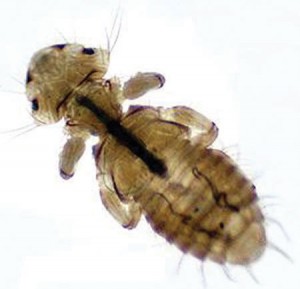 Lice are a common parasite of dogs in Utah. Lice are host-specific. That is, dog lice only affect dogs, and children who have head lice get them from other humans. Lice are visible to the naked eye, and are not very mobile. They are transmitted between dogs by direct contact. Your pet may pick up lice from playing with other dogs. Lice sometimes make pets very itchy, but some dogs have been found to have significant lice infestations with no itchiness at all! Many cases of lice infestation have been seen in Salt Lake City this winter. Treatment is usually fairly easy, as the insects are easily killed with flea shampoos, and typically do not live free in the environment. Still, all bedding should be washed or disposed of. Your veterinarian may also recommend treatment with a topical liquid such as Frontline® (fipronil) or Revolution® (selamectin).
Lice are a common parasite of dogs in Utah. Lice are host-specific. That is, dog lice only affect dogs, and children who have head lice get them from other humans. Lice are visible to the naked eye, and are not very mobile. They are transmitted between dogs by direct contact. Your pet may pick up lice from playing with other dogs. Lice sometimes make pets very itchy, but some dogs have been found to have significant lice infestations with no itchiness at all! Many cases of lice infestation have been seen in Salt Lake City this winter. Treatment is usually fairly easy, as the insects are easily killed with flea shampoos, and typically do not live free in the environment. Still, all bedding should be washed or disposed of. Your veterinarian may also recommend treatment with a topical liquid such as Frontline® (fipronil) or Revolution® (selamectin).
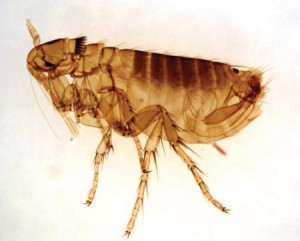 Fleas: Although fleas are less common in Utah than in other parts of the country due to our dry climate, our pets can still get fleas. Cases of flea infestation are seen with some regularity by local veterinarians in pets who have not been travelling. Fleas can be a significant problem for young or debilitated pets, can spread tapeworms, and may even spread disease such as Cat Scratch Disease and Plague to you or your pet. Fleas are fast moving insects, and may leave behind flea dirt which looks like pepper on your pet’s skin. They can be difficult to eradicate or control, as much of their life is spent off the pet in your house, and they can develop resistance to flea control products. Many products have been developed in the war against fleas, and each has some advantages and disadvantages. Revolution® is as effective topical insecticide, and Trifexis®, K9Advantix II®, and Frontline Plus® are topicals that include a flea-sterilizing ingredient as well. You should discuss what product may be the best option for your pet with your veterinarian.
Fleas: Although fleas are less common in Utah than in other parts of the country due to our dry climate, our pets can still get fleas. Cases of flea infestation are seen with some regularity by local veterinarians in pets who have not been travelling. Fleas can be a significant problem for young or debilitated pets, can spread tapeworms, and may even spread disease such as Cat Scratch Disease and Plague to you or your pet. Fleas are fast moving insects, and may leave behind flea dirt which looks like pepper on your pet’s skin. They can be difficult to eradicate or control, as much of their life is spent off the pet in your house, and they can develop resistance to flea control products. Many products have been developed in the war against fleas, and each has some advantages and disadvantages. Revolution® is as effective topical insecticide, and Trifexis®, K9Advantix II®, and Frontline Plus® are topicals that include a flea-sterilizing ingredient as well. You should discuss what product may be the best option for your pet with your veterinarian.
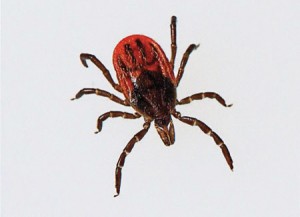 Ticks: Utah dogs may be exposed to ticks after spending time in the mountains or the desert. Ticks are skin parasites that feed on the blood of their hosts. Ticks can transmit infectious diseases such as Lyme disease, Ehrlichiosis, and Babesiosis and also cause “Tick paralysis” which is the result of a neurotoxin being transferred from tick to pet .Owners can usually prevent disease transmission to their pets by following a regular schedule of looking for and removing ticks. The best way to find ticks on your pet is to run your hands over their whole body. If you find a tick, the safest way to remove a tick is to use isopropyl alcohol and a pair of tweezers. Dribble alcohol on the tick, and then pull gently with tweezers near the attachment sight. If you leave part of the head in the dog a nasty sore may develop. The use of gloves is recommended to reduce the risk of disease transmission to you. Put the tick in alcohol or insecticide to kill it then dispose of it. Tick repellants are a great idea for dogs that spend significant time in our great outdoors, but tick collars usually don’t get the job done. Look for a topical tick repellant such as Frontline®, Revolution® or K9Advantix®.
Ticks: Utah dogs may be exposed to ticks after spending time in the mountains or the desert. Ticks are skin parasites that feed on the blood of their hosts. Ticks can transmit infectious diseases such as Lyme disease, Ehrlichiosis, and Babesiosis and also cause “Tick paralysis” which is the result of a neurotoxin being transferred from tick to pet .Owners can usually prevent disease transmission to their pets by following a regular schedule of looking for and removing ticks. The best way to find ticks on your pet is to run your hands over their whole body. If you find a tick, the safest way to remove a tick is to use isopropyl alcohol and a pair of tweezers. Dribble alcohol on the tick, and then pull gently with tweezers near the attachment sight. If you leave part of the head in the dog a nasty sore may develop. The use of gloves is recommended to reduce the risk of disease transmission to you. Put the tick in alcohol or insecticide to kill it then dispose of it. Tick repellants are a great idea for dogs that spend significant time in our great outdoors, but tick collars usually don’t get the job done. Look for a topical tick repellant such as Frontline®, Revolution® or K9Advantix®.
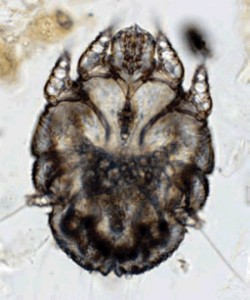 Sarcoptic mites: These mites are tiny and live buried deeply in the skin of infected dogs, primarily. Cats are uncommonly infected with this type of mite, and usually a different mite is involved. Infections are spread by direct contact between pets and are quite contagious. Dogs affected with sarcoptes can be tremendously itchy, often being suspected of having an allergy. Diagnosis involves a skin scraping being evaluated with a microscope for presence of the mites, but can be challenging, as the mites are often difficult to find. Because the mites can be hard to find, veterinarians often just treat for the parasite to address significant itching prior to pursuing allergy as the cause of itching. Treatment is usually simple and effective, but all dogs in the household must be treated with several rounds of medication. Mites do not live away from the pet for long, so household treatment is usually not necessary, although all bedding should be thoroughly washed or discarded.
Sarcoptic mites: These mites are tiny and live buried deeply in the skin of infected dogs, primarily. Cats are uncommonly infected with this type of mite, and usually a different mite is involved. Infections are spread by direct contact between pets and are quite contagious. Dogs affected with sarcoptes can be tremendously itchy, often being suspected of having an allergy. Diagnosis involves a skin scraping being evaluated with a microscope for presence of the mites, but can be challenging, as the mites are often difficult to find. Because the mites can be hard to find, veterinarians often just treat for the parasite to address significant itching prior to pursuing allergy as the cause of itching. Treatment is usually simple and effective, but all dogs in the household must be treated with several rounds of medication. Mites do not live away from the pet for long, so household treatment is usually not necessary, although all bedding should be thoroughly washed or discarded.
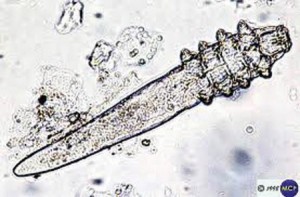 Demodectic mites: Commonly called “Mange”, demodex infections in dogs are common in puppies but uncommon in adult dogs. This parasite is a normal inhabitant of dogs’ hair follicles; however in young or immunosuppressed pets, it may multiply and cause significant hair loss. The condition is not contagious, and does not typically cause much itching. Short haired breeds may be more prone to the condition, and puppies may present with “moth-eaten” areas of hair loss around the head. Treatment is not necessary or recommended for localized demodecosis. When wide spread involvement is present, treatment can be quite challenging and is most commonly accomplished with ivermectin.
Demodectic mites: Commonly called “Mange”, demodex infections in dogs are common in puppies but uncommon in adult dogs. This parasite is a normal inhabitant of dogs’ hair follicles; however in young or immunosuppressed pets, it may multiply and cause significant hair loss. The condition is not contagious, and does not typically cause much itching. Short haired breeds may be more prone to the condition, and puppies may present with “moth-eaten” areas of hair loss around the head. Treatment is not necessary or recommended for localized demodecosis. When wide spread involvement is present, treatment can be quite challenging and is most commonly accomplished with ivermectin.
If your pet has an itchiness or other skin related symptoms, don’t hesitate to ask your veterinarian about what may be the cause and don’t be surprised if he/she wants to see your furry family member for a dermatologic examination.
Dr. Lynn McCarron is the owner of University Veterinary Hospital and Diagnostic Center in Salt Lake City She is Board certified in the veterinary care of canines and felines, and a member of the American Asssociation of Feline Practitioners. Originally from Ohio, Dr. McCarron has been practicing in Utah for more than twenty years.




